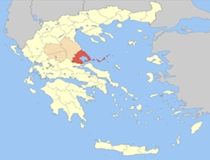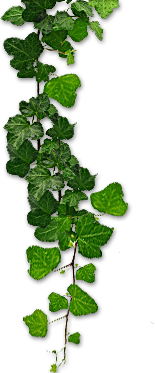
In the neighborhood of PROTESILAOS
The ARCHAEOLOGICAL footpath from the Mycenaean period in the Classical age
PTELEOS
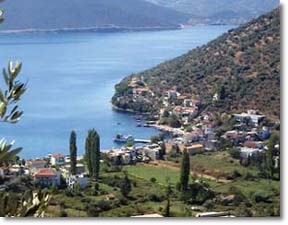 Pteleos is an ideal place for your holidays all year round, mainly though in
summer, when most tourists come. Each district of the municipal of Pteleos has
its own history and tradition which lives on in our days. Pteleos lies on the
south coast of the prefecture of Magnesia, 60 km to the south of Volos, opposite
the famous islands of Sporades. A group of settlements along the beautiful
coasts surround the main village, forming a lively community which combines in
harmony virgin nature with all modern facilities, shops, hotels, bars,
restaurants, first aid station etc. On the coast Pigadion and Ahillion are the
centre of life with picturesque ports, fish taverns serving seafood specialties
and night entertainment. In the municipal of Pteleos there are many historical
sights to admire such as the remains of Mycenean tombs, the Venetian castle in
Pigadion with its fantastic view, the well restored remains of an old windmill
in Hamak, the ruins of the village of Hamak, but also the biotope in Lihoura,
the mountain range of Othrys with its recently discovered caves and the maritime
museum in Ahillion. Apart from the historical sights there are also numerous
little churches and chapels which either due to their position or their history
are worth a visit. One should see the church of St.
Pteleos is an ideal place for your holidays all year round, mainly though in
summer, when most tourists come. Each district of the municipal of Pteleos has
its own history and tradition which lives on in our days. Pteleos lies on the
south coast of the prefecture of Magnesia, 60 km to the south of Volos, opposite
the famous islands of Sporades. A group of settlements along the beautiful
coasts surround the main village, forming a lively community which combines in
harmony virgin nature with all modern facilities, shops, hotels, bars,
restaurants, first aid station etc. On the coast Pigadion and Ahillion are the
centre of life with picturesque ports, fish taverns serving seafood specialties
and night entertainment. In the municipal of Pteleos there are many historical
sights to admire such as the remains of Mycenean tombs, the Venetian castle in
Pigadion with its fantastic view, the well restored remains of an old windmill
in Hamak, the ruins of the village of Hamak, but also the biotope in Lihoura,
the mountain range of Othrys with its recently discovered caves and the maritime
museum in Ahillion. Apart from the historical sights there are also numerous
little churches and chapels which either due to their position or their history
are worth a visit. One should see the church of St.
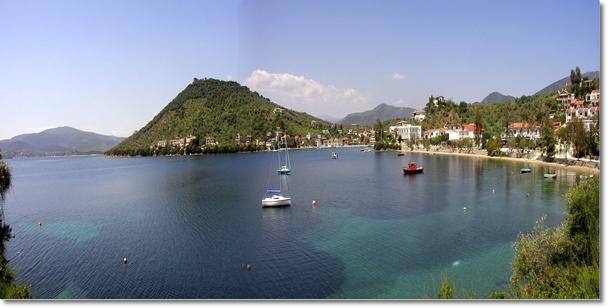 George
high up on a hill, from where you can admire the Gulf of Pagasitikos and the
mountain range of Pilion, at any time of the day or night! The beaches Agia
Marina, Lefki, Lihoura, Loutro, Pahiamos, Draka, Mitrouna, Kotsikia, Briniotissa,
Rodia, Panagia belong to the most beautiful and cleanest in the southeast of
Magnesia. Some of these are easily accessible, offer all facilities, other
places are more remote, ideal for romantic trips. Agios Dimitrios in the
district of Ahillion is a very popular beach of our area. After a long day at
the beach you can relax and refresh yourself at the many tavernas, cafes, bars
with fresh fish or amazing cocktails. All the beaches along with Pigadion have
been honoured with the "Golden Star" and "Blue Flag" awards for purity and
beauty of the landscape
George
high up on a hill, from where you can admire the Gulf of Pagasitikos and the
mountain range of Pilion, at any time of the day or night! The beaches Agia
Marina, Lefki, Lihoura, Loutro, Pahiamos, Draka, Mitrouna, Kotsikia, Briniotissa,
Rodia, Panagia belong to the most beautiful and cleanest in the southeast of
Magnesia. Some of these are easily accessible, offer all facilities, other
places are more remote, ideal for romantic trips. Agios Dimitrios in the
district of Ahillion is a very popular beach of our area. After a long day at
the beach you can relax and refresh yourself at the many tavernas, cafes, bars
with fresh fish or amazing cocktails. All the beaches along with Pigadion have
been honoured with the "Golden Star" and "Blue Flag" awards for purity and
beauty of the landscape
A FEW REMARKS ON THE HISTORY OF PTELEOS
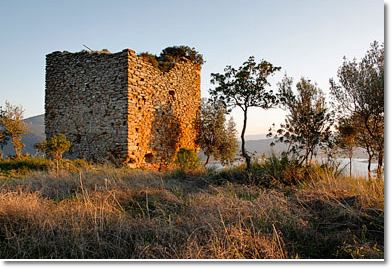 Pteleos
was first mentioned in pre-Homertimes. The name itself is amongst the few which
have preserved since ancient times. Ptelea = elm tree was according to belief
then a holy tree and according to the legend "The elm tree rose the grave of
Protesilaos" who had been killed in the Trojan War. Homer, the great poet, on
the other hand, does not referto the area as a region with elm trees. On the
list of ships which took part in the conquest of Troy, Pteleos is referred as "lehepii
(Lehos Ancient Greek, which is interpreted as 'bed' and "pii" means "poa, hloi"
meaning greenness, green vegetation) which should lead us to believe that
Pteleos was situated in a landscape full of "lush pastures". Set back in time
to the captivating mythological epoch there was Protesilaos, who was considered
"King to some and Prince to others" and who ruled over the ancient cities of
Filaki, Iton, Andron and Pteleos. He participated in the Trojan War with 40
battle ships, did not, however, die in combat, but the moment he disembarked his
own ship on the shores of Troy. Leaving myths behind and moving on to modern
times one can see that archeologists place the Prethessalic town of Pteleos near
the harbour of Pigadi. In the Middle Ages Pteleos was relocated to its position
today and is often mentioned in the chronicles of the Venetian and Turkish ruled
Thessaly. In the era of the Byzantine Empire vine and excellent wines were
abundant in the surroundings of Pteleos and as it says "The wine of Pteleos
flows as a precious produce in the Queen of all cities (Constantinople) regarded
a contemporary champagne (sparkling wine)". In the 15th century Pteleos was
called Ftelia or Ftelio.
Pteleos
was first mentioned in pre-Homertimes. The name itself is amongst the few which
have preserved since ancient times. Ptelea = elm tree was according to belief
then a holy tree and according to the legend "The elm tree rose the grave of
Protesilaos" who had been killed in the Trojan War. Homer, the great poet, on
the other hand, does not referto the area as a region with elm trees. On the
list of ships which took part in the conquest of Troy, Pteleos is referred as "lehepii
(Lehos Ancient Greek, which is interpreted as 'bed' and "pii" means "poa, hloi"
meaning greenness, green vegetation) which should lead us to believe that
Pteleos was situated in a landscape full of "lush pastures". Set back in time
to the captivating mythological epoch there was Protesilaos, who was considered
"King to some and Prince to others" and who ruled over the ancient cities of
Filaki, Iton, Andron and Pteleos. He participated in the Trojan War with 40
battle ships, did not, however, die in combat, but the moment he disembarked his
own ship on the shores of Troy. Leaving myths behind and moving on to modern
times one can see that archeologists place the Prethessalic town of Pteleos near
the harbour of Pigadi. In the Middle Ages Pteleos was relocated to its position
today and is often mentioned in the chronicles of the Venetian and Turkish ruled
Thessaly. In the era of the Byzantine Empire vine and excellent wines were
abundant in the surroundings of Pteleos and as it says "The wine of Pteleos
flows as a precious produce in the Queen of all cities (Constantinople) regarded
a contemporary champagne (sparkling wine)". In the 15th century Pteleos was
called Ftelia or Ftelio.
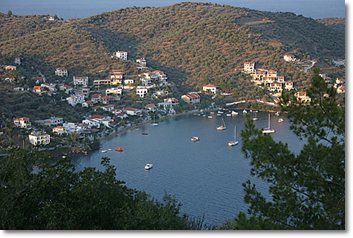 This
particular mention goes back to the historian Laonikos Halkokondili whom
Skouvaras quotes, recounting the conquest of Thessaly in 1423 by Tourhan Bey,
general of Sultan Mourat II. "There was no destruction or plundering as the
conquest had resulted from peaceful capitulation. "However, only on one
incident, in 1470, Sultan Mohammed II conquered the Thessalic forts Pteleos and
Gardiki, which the Venetians had been trying to hold desperately as they did not
want to submit to the Islamic Yoke. The Sultan had all male population above the
age of 12 executed "took over both Ftelia and Gardiki and left them in ruins".
He relocated all inhabitants to Constantinople, as well as women and children
from Evripos. In 1832 Turkish reign ceased. In 1835, when the Greek government
declared status of municipality for the people of Pteleos under Ftiotida, it was
referred to as "Pteleos". The parish was established underthe Royal Enactment of
His Majesty on 20th April in 1835 and consisted of 614 inhabitants, of which 287
lived in Pteleos,236 in Hamak,37 in Agii Theodori and 54 in Gagriani (today
Gavriani). In 1837 the town hall was transferred to Sourpi and in 1864 two
communities had been set up, the summer seat would be in Sourpi and the winter
seat in Pteleos. In 1999 due to new regulations and to facilitate services all
smaller communities were merged to one large municipal, which is today Pteleos.
This
particular mention goes back to the historian Laonikos Halkokondili whom
Skouvaras quotes, recounting the conquest of Thessaly in 1423 by Tourhan Bey,
general of Sultan Mourat II. "There was no destruction or plundering as the
conquest had resulted from peaceful capitulation. "However, only on one
incident, in 1470, Sultan Mohammed II conquered the Thessalic forts Pteleos and
Gardiki, which the Venetians had been trying to hold desperately as they did not
want to submit to the Islamic Yoke. The Sultan had all male population above the
age of 12 executed "took over both Ftelia and Gardiki and left them in ruins".
He relocated all inhabitants to Constantinople, as well as women and children
from Evripos. In 1832 Turkish reign ceased. In 1835, when the Greek government
declared status of municipality for the people of Pteleos under Ftiotida, it was
referred to as "Pteleos". The parish was established underthe Royal Enactment of
His Majesty on 20th April in 1835 and consisted of 614 inhabitants, of which 287
lived in Pteleos,236 in Hamak,37 in Agii Theodori and 54 in Gagriani (today
Gavriani). In 1837 the town hall was transferred to Sourpi and in 1864 two
communities had been set up, the summer seat would be in Sourpi and the winter
seat in Pteleos. In 1999 due to new regulations and to facilitate services all
smaller communities were merged to one large municipal, which is today Pteleos.
GAVRIANI
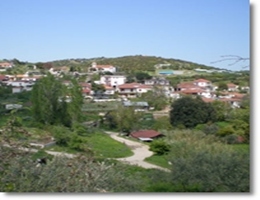
Gavriani
lies on the foot of Mount Othrys with its waterfalls and lush pine forests.
The
inhabitants occupy themselves mainly with stockbreeding (sheep and goats) and
crops, such as wheat, tee and herbs.
AHILLION
Modern Ahillion lies on the
end of the Gulf of Pteleos. Before 1920 the inhabitants lived further up in the
hills, a place called Hamak, which derived its name from the mother of Ali Pasha
Hamko.
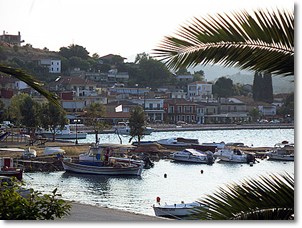 Today one can visit the old windmill, the ruins of the old village and
the old monastery with its frescos.
Today one can visit the old windmill, the ruins of the old village and
the old monastery with its frescos.
From excavations it is known that modern Ahillion had been a small settlement and it is said that the name Ahillion comes
from Ahilles, Homer's hero, who is reported to have lived there once.
People in Ahillion are occupied with agriculture (stockbreeding and olives) but also with
fishing and in the last few years with tourism (bed and breakfast, restaurants,
clubs, etc.).
The Maritime Museum is worth a visit, which exhibits all kinds of
shells, fish and equipment for fishermen.
AGII THEOGORI
Not much is known
about Agii Theodori from the old times.
The settlement was burnt down by the
Turks.
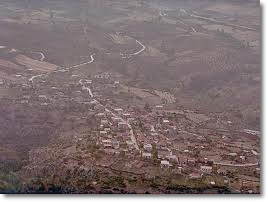
Hence the inhabitants lived a nomadic life.
In 1845 they decided to
settle down in today's position of the village due to the excellent climate
which prevails there.
Wheat and olives are harvested, and stockbreeding is the
main occupation. Visitors will love the clean fresh air and juicy lamb chops in
the tavernas.
OTHRYS
Towards inland rises the range of Othrys which is
reported to have been occupied in the ancient times.
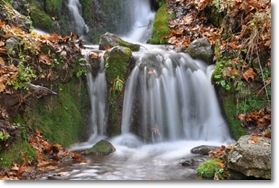
It has also been mentioned
in mythology (Battle of Titans) .
You can go trekking, visit old monasteries and
generally enjoy pristine nature.
Best time is from May to November, but even in
wintertime you could go ski trekking.
USEFUL NUNBERS
Town hall: (24220) -
41130,41227,41886,41887
Citizen Service Centre: (24220)) 41910 Fax 24220 41911
Hospital in Almiros: (24220) 22222,23991
Doctor in Pteleos: (24220) 41220
Pharmacy in Pteleos: (24220) 41317
Pharmacy in Ahillion: ((24220) 92610
GRAMMATIKEIO HIGH SCHOOL PTELEOS
The site ''
In
the neighborhood
of
Protesilaos:
The
Archaeological footpath from
the Mycenaean period
in the Classical age''
created the title
environmental program
developed by our
school
©
GRAMMATIKEIO HIGH
SCHOOL of PTELEOS


